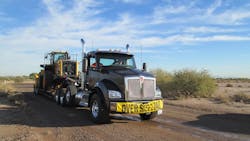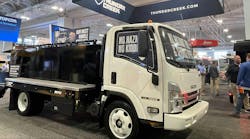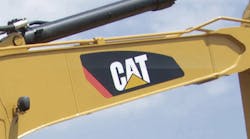According to the United States Department of Transportation, there are more than 500,000 truck accidents a year accounting for 2.4 percent of all vehicle accidents that occur in the country per year.
More than 75 percent of truck-related accidents that occur each year are due to the driver of a passenger car and only about 16 percent are found to be the fault of the truck driver; however, the condition of the truck itself can be a reason why truck accidents occur. That's why it is imperative that truck fleets or driver-owned commercial trucks be properly maintained.
This is often achieved with a commercial truck maintenance checklist. JB Tools, an online tool warehouse, has put together a pre-trip inspection guide based on Federal Motor Carrier Safety Administration (FMCSA) parameters.
Work truck pre-trip checklist
- The tires. According to the agency, the tires account for about one-third of the total maintenance costs of the vehicle. It advises inspection of tire air pressure and tread.
- The fluids. Drivers are encouraged to look for fluid leakage on pavement under the truck, check the coolant, antifreeze, oil, and fuel for leaks and whether there is the proper amount of fluid under the hood. The driver is also urged to turn on the ignition and examine the oil pressure, temperature, and air pressure gauges to assure they are working properly.
- Electrical system and wiring. All lights including headlights, warning lights, flashers, clearance lights, turn signals, brake lights, and other electrical components should be reviewed as well as wires to assure that everything is working properly and that the wires are not worn or loose.
- Brakes. The parking and standard brakes should be checked to assure that there is a proper amount of lining remaining, that there are no leaks in the air pressure system, that the low pressure warning alarm works properly, that parking brakes turn on automatically, and to assure the proper rate of air pressure buildup.
Things that are scheduled usually take place. That is probably why most people involved in fleet maintenance prefer scheduling maintenance activity.
Of course, the need for scheduled preventive maintenance is to prevent breakdowns from occurring, minimizing down time to make repairs, and assuring that the vehicle is operating safely.
A total maintenance program must be proactive and reactive. The idea is to minimize problems before they occur. However, there will be times when unscheduled repairs may be necessary.
An effective preventive maintenance program must include checklists that identify what is to be serviced and how frequently that service should be performed. The condition of the vehicle is the responsibility of the driver of the vehicle.
So it is up to him or her to perform inspections, provide details of the inspection in writing, and to notify appropriate people as to problems with the vehicle. Companies that rely on a fleet of commercial trucks should include a facility where a vehicle can be fixed or maintained that is staffed with professional automobile mechanics or technicians. The management of the facility can be performed by an in-house staff or outsourced.
Details of scheduled preventive maintenance should be documented and the documentation should be kept. Such documentation is usually achieved with the use of a preventive maintenance service checklist. The checklist should include a list of items on the vehicle to be inspected and should provide space to indicate the result of the inspection.
Checklist for scheduled preventive maintenance on work trucks
- Engine oil and filter changes
- Transmission fluid
- Fuel system
- Cooling system
- Engine and transmission mounts
- Drive shafts or CV joints
- Belts and hoses
- Tune-ups
- Electrical system components
- Braking system
- Steering and suspension system
- Tires
- Wheels and rims
- Exhaust system
- Undercarriage and frame
- Exterior and interior lights
- Body, glass, and mirrors
- Windshield wiper system
- Horn
- Seatbelts and seat structure
- Fluid leaks
- Auxiliary systems
Time between servicing and inspection should be included in the truck maintenance checklist. Refer to the vehicle owner’s manual for the manufacturer’s recommendations for intervals between service and inspection.
The fleet manager or truck driver should be personally responsible for the preventive maintenance scheduling. There is also preventive maintenance software available that can perform this task.
Source: JB Tools





